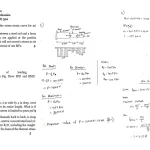Engineering mechanics forms the foundation of many engineering disciplines, exploring the behavior of physical systems under forces and motion. This guide provides a diverse set of questions and answers across various topics in engineering mechanics to help students understand concepts and prepare effectively for exams.
Statics
Question: What is the principle of transmissibility of forces?
Answer: The principle of transmissibility states that a force can be applied at any point along its line of action without changing the external effects on a rigid body.
Question: Define equilibrium in the context of statics.
Answer: Equilibrium occurs when a system or body remains at rest or moves with constant velocity due to balanced forces and moments acting on it.
Question: What are the conditions for static equilibrium in two dimensions?
Answer: The conditions are:
- The sum of all horizontal forces equals zero.
- The sum of all vertical forces equals zero.
- The sum of moments about any point equals zero.
Question: How do you calculate the resultant force of a system?
Answer: The resultant force is calculated by vectorially adding all the forces acting on the system.
Question: What is a free body diagram?
Answer: A free body diagram is a graphical representation of a body showing all external forces, moments, and reactions acting on it.
Question: Differentiate between scalar and vector quantities with examples.
Answer: Scalars have magnitude only (e.g., mass, time), while vectors have both magnitude and direction (e.g., force, velocity).
Question: What is the parallelogram law of vector addition?
Answer: It states that if two vectors are represented as adjacent sides of a parallelogram, their resultant is represented by the diagonal passing through the common origin.
Question: Explain the concept of moment of a force.
Answer: The moment of a force is the tendency of the force to rotate a body about a point or axis, calculated as the product of the force and its perpendicular distance from the point or axis.
Question: Define couple and its properties.
Answer: A couple is a pair of equal and opposite forces whose lines of action do not coincide, causing rotation without translation.
Question: What is the centroid of a body?
Answer: The centroid is the geometric center of a body or object, where its area or volume is equally distributed in all directions.
Dynamics
Question: What is Newton’s second law of motion?
Answer: It states that the rate of change of momentum of a body is proportional to the net force acting on it and occurs in the direction of the force (F = ma).
Question: Define kinematics and kinetics.
Answer: Kinematics studies the motion of objects without considering forces, while kinetics examines the motion due to forces.
Question: How is the equation of motion derived for uniformly accelerated motion?
Answer: The equations are derived by integrating the acceleration to find velocity and displacement over time.
Question: What is the principle of conservation of momentum?
Answer: It states that the total momentum of a system remains constant if no external forces act on it.
Question: Define angular velocity and angular acceleration.
Answer: Angular velocity is the rate of change of angular displacement, while angular acceleration is the rate of change of angular velocity.
Question: How do you calculate the work done by a force?
Answer: Work is calculated as the product of the force and the displacement in the direction of the force (W = F × d × cosθ).
Question: What is the energy conservation principle?
Answer: Energy cannot be created or destroyed; it can only be transformed from one form to another, with the total energy of an isolated system remaining constant.
Question: What is impulse, and how is it related to momentum?
Answer: Impulse is the product of force and time over which it acts. It equals the change in momentum of a body.
Question: Explain the term “centripetal force.”
Answer: Centripetal force is the inward force required to keep a body moving in a circular path.
Question: What is the difference between elastic and inelastic collisions?
Answer: In elastic collisions, both momentum and kinetic energy are conserved, while in inelastic collisions, only momentum is conserved.
Understanding engineering mechanics involves mastering the principles of statics, dynamics, and related concepts. This compilation of questions and answers serves as a valuable resource for deepening knowledge and aiding exam preparation.
Latest Posts
- Step-by-step guide to download and apply for jee mains admit card 202
- Comprehensive 2025 government holidays and recruitment details for job seekers
- JEE Mains Admit Card 2025: Your Step-by-Step Guide to Downloading the Hall Ticket
- Everything You Need to Know About 2025 Government Holidays Recruitment
- Comprehensive Guide to rrb d group recruitment 2025 – Eligibility, Vacancies, and Application
- Detailed guide to nps trust recruitment 2025 vacancies, eligibility and apply process
- Comprehensive guide to hpcl recruitment 2025 notification, vacancies, and application process
- ignou bed admission 2025 complete recruitment guide with eligibility and process
- Comprehensive Guide to Indian Army Agniveer Recruitment 2025 Notification and Jobs
- Everything You Must Know About CBSE Board Exams 2025 Changes & New Rules






